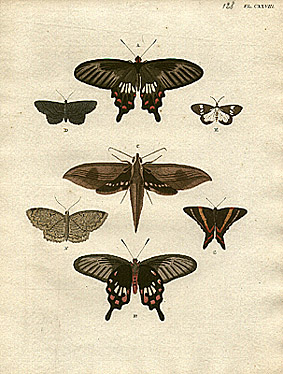
Gerrit Wartenaar
Encyclopedia

Jordaan
The Jordaan is a district of the city of Amsterdam in the Netherlands. The area is bordered by the Lijnbaansgracht canal to the west, the Prinsengracht to the east, the Brouwersgracht to the north and the Leidsegracht to the south...
.
Pieter Cramer
Pieter Cramer
Pieter Cramer , was a wealthy Dutch merchant in linen and Spanish wool, and an entomologist. Cramer was the director of the Zealand Society, a scientific society located in Flushing and a member of Concordia et Libertate, based in Amsterdam...
, the director of a scientific society in Zeeland
Zeeland
Zeeland , also called Zealand in English, is the westernmost province of the Netherlands. The province, located in the south-west of the country, consists of a number of islands and a strip bordering Belgium. Its capital is Middelburg. With a population of about 380,000, its area is about...
assembled an extensive natural history
Natural history
Natural history is the scientific research of plants or animals, leaning more towards observational rather than experimental methods of study, and encompasses more research published in magazines than in academic journals. Grouped among the natural sciences, natural history is the systematic study...
collection of colourful butterflies and moths (Lepidoptera
Lepidoptera
Lepidoptera is a large order of insects that includes moths and butterflies . It is one of the most widespread and widely recognizable insect orders in the world, encompassing moths and the three superfamilies of butterflies, skipper butterflies, and moth-butterflies...
). In his will Cramer commissioned to publish the drawings he had ordered. Between 1775 and 1782 four volumes appeared in Amsterdam of De uitlandsche Kapellen voorkomende in de drie Waereld-Deelen Asia, Africa en America - Papillons exotiques des trois parties du monde l'Asie, l'Afrique et l'Amerique.
When Cramer died during the preparations, Caspar Stoll
Caspar Stoll
Caspar Stoll was born in Hessen-Kassel , probably between 1725 and 1730. Being either a clerk or a porter at the Admiralty of Amsterdam, he published several works on entomology. Stoll's publications of stick insects, mantids and their relatives are particularly well known.-Life:In 1791 Stoll wrote...
took over the responsibility for the project. 270 people subscribed, who enjoyed some reduction. Every three months an issue was delivered. Not Stoll, producing 25 issues and the supplement, but Wartenaar was the draughtsman of the plates.
The drawings are scientifically very accurate although somewhat stylized. Wartenaar positioned each specimen in a pleasing decorative arrangement, perhaps reflecting the position of specimens in the collector's cabinet of curiosities. As most of the insect specimens used by Cramer and Stoll to describe new species have long since perished, the original drawings now have a special scientific status as iconotypes.
Wartenaar lived all his life on Egelantiersgracht. In 1781 he drew a map of his neighborhood. Gerrit Wartenaar, a childless widower, was buried in Westerkerk
Westerkerk
The Westerkerk is a church of the Protestant Church in the Netherlands denomination in Amsterdam, built in 1620-1631 after a design by Hendrick de Keyser. It is next to Amsterdam's Jordaan district, on the bank of the Prinsengracht canal....
.

